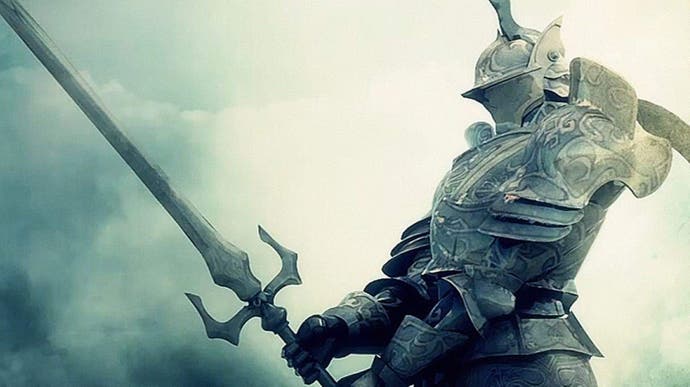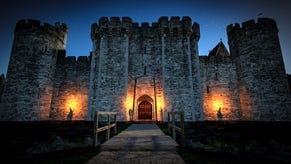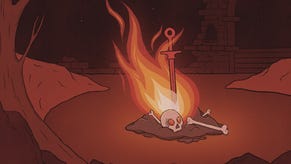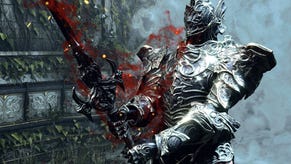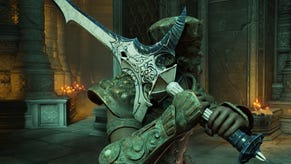Why it's time for a PS4 Demon's Souls remake
Sony owns the IP - which opens up some mouthwatering possibilities.
Developed exclusively for PlayStation 3, Demon's Souls is arguably the most overlooked game in the Souls series. It was a revelation in 2009 and also something of a mystery as players took their first uncertain steps into Boletaria. From the gothic palace front to its dragon-besieged bridges, every area was built to create a unique sense of dread. The game's status as being playable on just one console has only added to the game's allure over the years. With Dark Souls getting imminent remaster treatment, Demon's Souls will soon be the only Souls game that isn't playable on PS4. And with online servers having shut down earlier this year - almost a decade on from release - the appeal of a modern-day remaster is undeniable.
There is an argument that Demon's Souls has been surpassed by its multi-platform successors but there's still a lot to praise in the PS3 original. Next to Dark Souls or Bloodborne, the atmosphere of Demon's Souls still carries weight - from the eerie calm of the Nexus hub area, each Archstone gives access to increasingly horrifying areas and enemies. Mechanically, it feels like a successful prototype for later games - a credit to From Software's willingness to experiment. Demon's Souls reprised the horror-fantasy aspect of its own Kings Field series - but it did so with a few major new twists - between its third person targeting system, 3D world navigation, the blood-stain mechanic, and online networking, the DNA of the Souls series was established.
Perhaps Demon's Souls' most distinctive design choice is its use of Havok physics. Like its successors, physics properties play an integral part in hit detection on shields and armour as you navigate each corner - so for example, larger shields logically give more coverage from head-to-toe from oncoming arrows, while a player's angle, height, and position play into the dynamic too. It creates a genuine sense of a physical presence in the world, and the same goes for the environmental details. Whether it's the smashing barrels or sentry blocks, dangling chains, rolling cannonballs, or even the rubber chicken-style ragdoll physics - From Software made use of PS3's Cell processor to fill static environments with more life and movement.
Two years later, Dark Souls expanded on these ideas with a fully contiguous world, but it's in Demon's Souls that From Software nailed the core tenets of play. Every Souls game since has aimed to create more complex environments and enemies; especially looking at Bloodborne on PS4 with its reworked lighting model and more detailed shaders. Even so, Demon's Souls still resonates today, and the core formula still scratches the same itch; whether that's the tense chase for the last blood stain, or meticulously deciphering an enemy's weak point. The only caveat: thaat nine years difference shows on the surface level, and it's certainly been left behind in the technological stakes. A remaster is needed - indeed, based on our tests, there's a strong argument that we're going to need something more than that, something truly special to make the most of the opportunity.
Without being too harsh on an experimental 2009 title, let's consider the options. Looking at the game's playback on PS3, there are shortcomings that could easily be updated for the modern day, and others that would involve more manpower to achieve. An easy pick is the resolution, stuck as it is at a native 1280x720 on PlayStation 3. 720p in itself is expected of the era, though image quality was rough even at the time, with no anti-aliasing showing across a character's sharp armour outlines. A boost to 1080p on PS4 - and beyond on PS4 Pro - would be a fair expectation here, along with a more even frame-rate. Just as with Dark Souls, between the heavy physics interactions and deluge of alpha effects, sub-30fps drops are certainly commonplace.
All this can be fixed on modern hardware. With a 30fps cap, it's no surprise the Souls series' distinctive frame-pacing issue are present, adding that erratic motion even in the best-case on PS3. For a PS4 remaster in the vein of Dark Souls, which does target 60fps, those frame-time spikes could be fixed by avoiding a cap altogether. At the very least a stable 30fps is a must for a remaster to feel justifiable, though taking this half-refresh route would raise the hope for a more ambitious overhaul to its core visuals .
Much of this can be tested right now. Case in point: replaying the game this week has been an eye-opener, not just to see it on original hardware, but also via emulation on PC. It's come a long way, but the technologically ambitious RPCS3 emulator runs Demon's Souls surprisingly well; it's stable, and can even be forced to run at a full, native 4K resolution, with anisotropic filtering ramped up to the max. The key take-away? A resolution bump alone won't cut it for Demon's Souls re-release, and likely a move to 60fps won't fully satisfy either. A lot more work is needed.

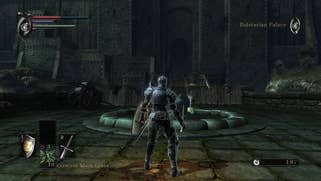
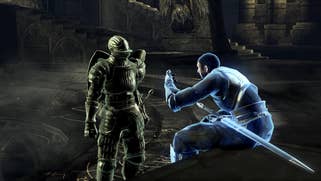


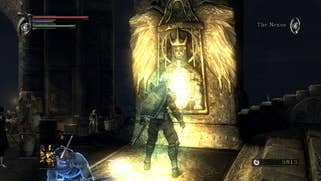
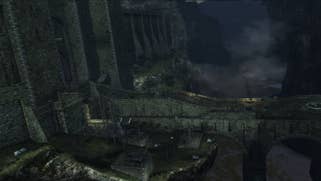

Alas, frame-rates on PC emulation are beholden to the original game design, meaning we're still only hitting 30fps at best - and RPCS3 itself is far from the finished article, with Havok physics seemingly engaging one CPU thread, which clearly isn't coping with the demands placed on it. But the point of the exercise here is to see how well the original game scales onto modern displays. At 4K, it proves that a basic 9x increase in resolution can flatter the original Demon's Souls' design, but only to a point.
On the plus side, 4K playback can flatter PS3's original settings; draw distances are surprisingly far-flung, for example - with barely any pop-in in sight on Boletaria Palace's opening bridge. However, equally, the higher-res window reveals some ugly truths. Environments stick to a rigid, geometric design, with visibly low resolution texture-work built to PS3's restrictive video RAM limits. Inevitably, the distant 2D backdrops also come across as flat and disconnected from the scene. Even with the helping hand of 16x texture filtering, it's clear that a PS4 version will need reworked assets to make 1080p, or even 4K passable on the modern PlayStation consoles. Equally, post-effects like depth of field run with a low-res buffer that fit 720p original quite nicely, but on a larger scale will need tweaking.
Running under emulation is an interesting exercise in what a straight remaster could deliver. Ultimately though, it demonstrates some profound limitations in the original assets. There's still a great game here, but a tweaked remaster in the style of the upcoming Dark Souls offering would fall short of expectations; at such a high resolution, the reality is different to the memory. To work on the current PlayStation generation, it's fair to suggest we'd need new artwork, improved character and environment modelling and a revised post-process pipeline. In essence, we're moving from remaster to remake territory here - and while there's a wealth of talent out there capable of handling the job, the obvious choice for the project would be Bluepoint, the masters of the remaster.
Hot on the heels of the excellent Shadow of the Colossus remake- which rebuilt the game on its own engine using new assets, the team has noted it's already working on a bigger project. Whether or not Demon's Souls is the game in question remains to be seen - and is likely wishful thinking on our part - but what what's clear is that the approach Bluepoint has taken on Shadow of the Colossus is a perfect fit for rejuvenating Demon's Souls on current-gen hardware. What we're after is something that toes the line between a remaster and a more ambitious remake, keeping the core game logic intact while revamping the visuals extensively - a formula Bluepoint has experience with.
Shadow of the Colossus's re-release wasn't just about the visuals, and neither should it be for Demon's Souls. You can add a laundry list of quality of life improvements to the experience too. Over time, the Souls series made its menus easier to navigate, and those changes could be retrofitted into a remake. Using multiple hero souls for example was a chore in Demon's Souls, leaving you to use each one in turn rather than as a group. Likewise, you had to level up each stat individually, one at a time, rather than being able to do several in one go. Later games streamlined this, and much more - all points would be factored back into a potential remake.
All this is speculative of course, but the fact is that Demon's Souls has a special place in the hearts of gamers who imported it - myself included - all the way from Asia back in 2009. It's only via positive word of mouth from enthusiasts that Demon's Souls eventually made its way West - but even then, there was no telling then how big the series would become. Four Souls games later, if we include Bloodborne, Demon's Souls is still fondly remembered for that brutal gothic fantasy setting, and the introduction of many mechanics we take for granted in the series. However as each new game improves on the last, as it stands, it's the one Souls title that risks being lost to time.
A curious point here is that Demon's Souls is a platform exclusive owned by Sony, a state of affairs confirmed by From Software's Hidetaka Miyazaki, who also states that any remaster would be entirely down to the platform holder. This opens up a mouthwatering prospect in the wake of the sheer quality offered up by Shadow of the Colossus. With the Bluepoint template in mind, a potential Demon's Souls remake is an opportunity to bring a new spin to the Souls franchise; to deliver an alternative vision to how the series could have evolved if it hadn't transitioned into a multiplatform franchise. A Demon's Souls remake with the sheer attention to detail and quality we've seen from Sony's first party output? That would be incredible.
